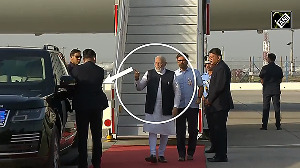Outside a crowded Delhi mall, heads turn as a big, black bus rolls in. It's covered with ads for a mobile phone, from the overhead carrier to down to the hubcaps.
A team of salespeople, all sporting the Motorola logo prominently on their shirts, set up a stall inside the bus. They're conducting product demos of the latest Motorola cellphone models.
Meanwhile, at around the same time, but at another mall, Korean giant LG is busy creating an entertainment zone inside a truck. Shoppers can drop by to try 15 to 20 different games, all meant for LG mobile handsets, but played out on a giant screen.
This seems like just a little lighthearted fun, but you don't need to scratch the surface too hard to realise that it's very serious business for these companies. The Indian cellular telephony market is now adding close to 4 million new mobile connections (GSM as well as CDMA) every month (source: Cellular Operators Association of India).
That's 4 million new handsets that could be sold every month - and we're not even counting the replacement market just yet. Naturally, handset manufacturers are working hard to ensure they don't miss the bus (or the truck, in LG's case).
But the party started way back - and they weren't even invited. The mobile handsets industry is growing at nearly 50 per cent every year and 33 million new GSM handsets are expected to be sold in 2006. And Nokia leads by a mile.
According to research agency ORG Gfk, Nokia's market share, as of February 2006, is a staggering 78.8 per cent. Relatively, Samsung's is 6.4 per cent, Motorola 4.6 per cent, Sony Ericsson is at 5.1 per cent and LG's share is 2.5 per cent.
India ready for luxury mobile phones?
Nokia may be the first choice, but the others are not losing hope. The replacement market in India is growing huge, after all. Two years ago, the replacement market for mobile phones was barely 8-10 per cent of the total sales.
At present, it accounts for a 20-25 per cent share. Assuming that a quarter of mobile phone users change their mobile phones every year, the replacement market could be worth fighting for - 8 million sets in a year.
So how are the others trying to catch up with Nokia, in a game that it's best at?
Give me more
The first point of entry into the customer's mind is through the product. According to the February 2006 report by ORG-Gfk, 57 per cent of the total handset sales in the top 35 cities were colour screen mobile phones.
That's a significant change: in October 2004, colour screen phones accounted for just 25 per cent of sales. But a dash of colour is not enough. Roughly one-fourth of the colour screen phones that are sold also have cameras.
A study by handset manufacturer BenQ in 2005 confirmed that customers expect their mobiles to be more than just communication devices. BenQ found that men were keen on camera phones, while women preferred music on the phone.
Based on these findings, the Taiwanese company launched the M 220, a colour phone with a radio that was targeted specifically at women. The price point: Rs 4,500. The company claims that the competing models were priced from Rs 5,000-7000, but these models had a camera too.
Says Ish Bawa, marketing and communications head, BenQ India, "Cellular phones are not just about connectivity. It's about what more you can offer customers, like cameras, radios and so on."
BenQ claims to have been the first one to offer a full-colour model with a radio: other phones either also had a camera or were mono colour phones with a radio.
Bawa says the M 220 managed sales of 5,000-6,000 units every month and is the company's most popular model - it accounts for fully half the company's sales. And according to the company's warranty card analysis, at least 35 per cent of the buyers of the M 220 were women.
Of course, the real figure could be even higher - very often, men buy the product, but women are the end-users.
Around the same time last year, Sony Ericsson extended Sony's acclaimed Walkman brand to its mobile phones. Launched as the Walkman series, the company claims its W800 and W550 models are its largest selling models in that segment and make up nearly 20 per cent of the company's sales.
Of course, it's not just music. Manufacturers are also expanding their range to combat Nokia's 38 models in India. Until six months ago, Motorola had just five or six models available in the market; it now has 18. In just one month, February 2006, the Indian handsets market saw the launch of 14 new models, most of them from Motorola and BenQ.
Scaling the wallet
Prices of mobile phones go only one way: down. Right? Wrong. Consider the entry of Vertu, a top-of-the-line brand that's owned by Nokia.
Launched in 2004, Vertu straddles the price point of Rs 240,000 all the way up to Rs 35 lakh (you could buy a Mercedes at that price).
Of course, Vertu is a luxury brand and market share figures are probably irrelevant in its case. But what explains Samsung's pricing strategy?
The Korean electronics giant has ensured it's consistently priced at the top-end in each segment of the mobile phones market. That's in keeping with its high-on-design and premium positioning. Says Samsung Mobiles' Marketing Head, Asim Warsi, "It's a certain amount of brand premium we consciously choose to carry."
Those are the exceptions; consider the others. Less than a year ago, Motorola's models were at three price points: Rs 3,000, Rs 10,000 and Rs 20,000. Now, the Motorola base model carries a Rs 1,600 sticker, while the top end costs Rs 18,000.
For models like the Pebl, launched in March 2006, Motorola even offers a zero-interest finance scheme. The company claims its market share has increased from 2.8 per cent to 4.6 per cent in February 2006. "Motorola has been the biggest gainer this month," agrees the ORG-Gfk report.
Even other manufacturers agree that pricing is a key part of their strategy. For instance, BenQ targets lower-end users who would otherwise opt for a mono colour phone.
In November 2005, BenQ dropped the price of its entry level colour screen phone, from Rs 4,300 to Rs 3,300. The model was now within striking distance of mono colour phones that were available for Rs 2,500-3,000.
Selling point
You may find a mobile in every hand, at least in the big cities. But penetration in India is still very low - 6 per cent compared to 50-60 per cent in Singapore.
Which is why handset manufacturers are looking at different ways to increase distribution. LG focuses on the youth. The company has entered into tie-ups with coffee chains and multiplex owners (Barista and PVR Cinema) to display its models at their locations.
LG is also in the process of increasing its reach from 11,000 outlets to 20,000 by December 2006 and is even considering network marketing to increase its presence across the country.
Motorola has opted to tie-up with fixed line instrument manufacturer Bharti Teletech to manage its national distribution (Nokia's got HCL for something similar). The tie-up (Bharat Moto) increased Motorola's presence in semi-urban towns and rural areas and the company claims its distribution has trebled and market share has doubled as a result.
If Nokia recruits top managers from multinationals like Hindustan Lever, then Motorola has also made friends with FMCG companies.
In March 2006, Motorola roped in ITC's e-choupal (a network that links to 3.5 million farmers through Internet kiosks) and with Hariyali Kisan Bazaar, a chain of retail outlets where farmers buy farm equipment.
Mobiles may be displayed alongside seeds and fertilisers, but "ITC reaches very small towns and enjoys strong customer loyalty," points out Sudhir Agarwal, director, sales, India, Nepal and Sri Lanka, mobile devices, Motorola.
Meanwhile, in March 2005, BenQ started focusing on the key 20 cities (from 70-80 cities), even though it dropped market shares: from 3 to 1 per cent. But Bawa defends the move. "We want to cement our presence in the metros and bigger cities. Our shares in the top 20 cities has actually increased 60-70 per cent post the consolidation," he says.
Apart from this, BenQ has also tied up with Neoteric - the national distributors for Kodak. The logic: when customers buy cameras, they could also go back with a camera phone. The company is also extending buy back offers and discounts at these outlets. BenQ claims that 25-30 per cent of its sales now happen through the Neoteric tie-up.
Make in India
Even as companies work on their distribution, they are also bringing handset manufacture closer home. Nokia recently had a high profile launch of its manufacturing facility in Tamil Nadu.
Says Warsi, "Samsung decided to set up its manufacturing base in India to cater to the huge demand expected here." Samsung's unit at Manesar, in Gurgaon, which began production in March 2006, will make 1 million units in its first year of operation.
LG, which also has a manufacturing facility in Pune, claims that setting up a local manufacturing unit has more benefits that economies of scale or savings on logistics - product modification, for instance. Two just-launched LG phones have a cricket game, based on customer feedback on the popularity of the sport here.
"We wouldn't have been able to meet market requirements if the product were being made elsewhere," points out H S Bhatia, product group head, GSM mobiles, LG.
With product, price and distribution in place, companies need to shore up their advertising. But most manufacturers focus on product-specific, rather than brand-building, advertisements.
For instance, Samsung's high-end phone D 500 is advertised on English news and movie channels, while its X 200 a mass phone is advertised in general entertainment channels and regional dailies.
"Our products are our brand ambassadors," says Samsung's Warsi. But despite such claims, times could change. Motorola has signed a brand ambassador and has launched a teaser campaign inviting viewers to guess who it could be. Maybe the ambassador will walk out of the bus in the Delhi mall.







 © 2025
© 2025